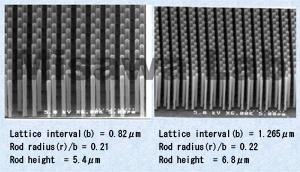Efficient Creation of Energy by Nanostructures
We study on highly efficient optical antennae based on metallic nanostructures, and develop solar cells as well as artificial- photosynthesis systems which evolve oxygen and hydrogen as a result of a photolysis of water.
Since the probability of light matter coupling process is not so large originally, effective utilization of light in optical devices is needed. We have recently elucidated the possibility of plasmonic nanostructures as an optical antenna for visible and near infrared light and enhancing light matter coupling process. Applications to various fields are expected such as a solar cell enabling light energy conversion with a small amount of substance.
Furthermore, the photoelectric conversion system employs water molecules as electron sources. To study further detailed mechanism of the light-energy conversion system, we also address ultra-fast spectroscopy and imaging for the purpose of pursuing electron transfer dynamics from optical antenna to semiconductor electrode as an example. We also study on the development of artificial-photosynthesis systems such as plasmon-induced water splitting and ammonia production systems which attract attention as an energy career.
Research Interests
- Near-infrared solar cell/artificial photosynthesis
- Femtosecond laser processing
- Photonic crystal
Near-infrared solar cell/artificial photosynthesis

It is known that near-infrared light at wavelengths of 800 to 1,100 nm can easily penetrate living organisms. We aim to develop a solar cell equipped with a nanometer-sized optical antenna (metallic nanostructure) that can harvest near-infrared light, and then to develop an implantable solar cell to which energy can be supplied from outside the body. Using this system, we plan to advance research with a view to applying it to artificial photosynthesis systems such as the complete water splitting (evolution of both hydrogen and oxygen) by infrared light irradiation and the fixation of carbon dioxide.
Femtosecond laser processing

Non-linear optical phenomena such as multiphoton absorption and quantum phenomena including tunnel ionization can easily be observed under high-photon density conditions created by a focused femtosecond laser. Using this, we studied on three-dimensional fabrication with super resolution, for which only the inside of transparent material is produced without damaging the surface with resolution under the diffraction limit of light to fabricate 3D memories, photonic crystals and microchannel chips. We also study semiconductor processing, including silicon, metal such as stainless steel, and ceramics such as single crystal sapphire.
Photonic crystal

By semiconductor processing technology and aluminum anodic oxidation, we fabricate submicron periodic structures called photonic crystals (2D) that can trap light, and studied their optical properties. We also fabricate 3D photonic crystals that can trap more light by self-organized periodic polymer microparticles and femtosecond laser processing, and studied their optical properties. We use these various photonic crystals to build new optical waveguide structures, microscopic laser resonators and photochemical reaction fields.
